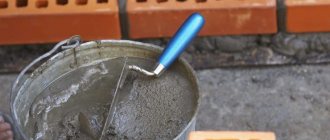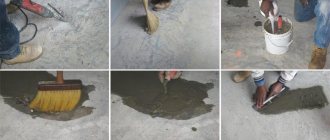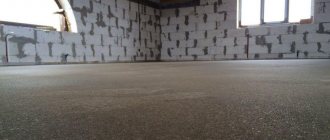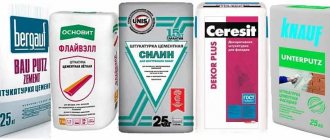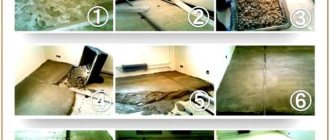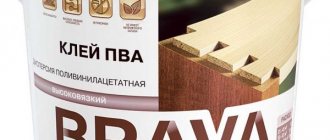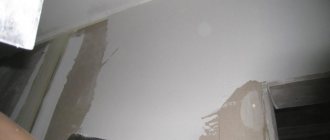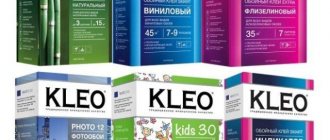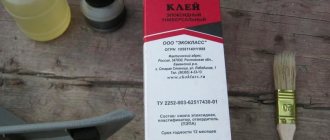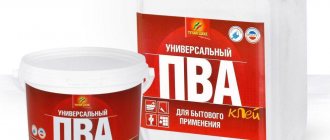It is problematic to imagine carrying out construction activities without the use of Portland cement mixed with fine sand. Cement-sand mixture is always in demand in the construction industry. It is used for masonry, installation, finishing, and plastering work. Builders use ready-made dry mixtures produced in industrial conditions, as well as independently prepared compositions. Let's look at the types and labeling of building materials. Let's look at the characteristics and use of cement-sand mortars.
Cement-sand mixtures - types and characteristics
Professional builders call cement-sand mixtures for short - CSP. The abbreviation is widely used on specialized websites. The mixtures have different characteristics.
As building materials developed, a large number of ready-made building cement-sand mixtures appeared
DSPs are classified into types depending on the following factors:
- functional purpose. The cement mixture is used to form screeds, plastering and laying walls made of various building materials, as well as performing facing activities;
- specific gravity of the hardened composition. The density of the finished cement-sand screed or masonry mortar after hardening is up to 1.5 t/m3 for lightweight compositions and above the specified value for heavy ones;
- strength properties of the hardened mortar. The main characteristic is compressive strength. It is designated by the capital letter M together with a number characterizing the load capacity in kg/cm2;
- amount of binding ingredients. Depending on the formulation and application features, slaked lime, gypsum powder and other components are additionally included;
- binder content. If the volume of sand is five times greater than that of cement, the solution is depleted; if the proportion of sand to cement is less than three, the solution is fatty. In normal mixtures, the proportion of sand to cement is 4:1.
The concentration of ingredients in the working composition determines its characteristics:
- hardening intensity;
- margin of safety.
Lean compositions harden slowly and crumble over time. Fatty CPS are characterized by accelerated hardening, followed by cracking. The correctly selected brand and amount of cement, as well as adherence to the recipe, guarantee performance properties.
The main characteristics of solutions based on Portland cement:
- ability to maintain integrity under temperature changes;
- duration of operational strength development;
- moisture resistance of the hardened solution;
- plasticity, making work easier.
When choosing a DSP to perform specific tasks, you need to take into account that the properties are determined by the brand of binder and its quantity in the total volume.
Each ready-made mixture must be accompanied by instructions on the required amount of water; other components are usually not provided
How to properly dilute
Before preparing the mixture, you need to find out how to dilute the cement correctly. Changing the order of work and violating the technology entails a decrease in the technical characteristics of the material, which is unacceptable.
How to dilute cement and other components correctly:
- Filling the container with one layer of cement, then a layer of sand and alternating until the number of layers reaches at least six. Cement and sand should be poured in the form of a bed with a total height of up to 30 centimeters.
- Mix the dry ingredients in a container with a shovel until a homogeneous mass is obtained. Sift the composition through a sieve with 3x3 millimeter mesh. This is necessary to ensure uniformity of the composition.
- After all the components are mixed (sand and cement), the solution can be mixed. Water is added carefully and gradually, slowly, fully controlling the density level of the CSP.
When preparing a solution, the ratio of sand and cement, the quality of materials and water play a key role. So, it is important to use the liquid at the right temperature - the water should not be very hot and not very cold, as close as possible to the natural environment. The air temperature should be above +5 degrees.
What is the composition of the cement-sand mixture?
The standard mixture is made based on the following ingredients:
- cement of the appropriate brand;
- fine sand, cleared of foreign particles;
- modifiers that improve the characteristics of the finished mixture;
- water introduced until the solution becomes plastic.
These components are thoroughly mixed for uniform distribution throughout the volume. Building codes allow the addition of coloring pigments, as well as reinforcing fibers.
The share of introduced ingredients is determined by the following factors:
- area of application of the solution. Depending on the purpose, the amount of ingredients introduced changes;
- brand of Portland cement used. When using high grade cement, the quality of the composition improves;
- date of manufacture of the binder. During prolonged storage, Portland cement loses its performance properties;
- moisture concentration in the feedstock. If the moisture content of the components is high, a reduced volume of water is added.
Sand-cement mixture is one of the most common materials.
Let's consider how much Portland cement and sand you need to take to prepare solutions for various purposes:
- The composition for the screed includes Portland cement grade M300–M350 and sand, mixed in a ratio of 1:3. The introduction of fiber reinforcement increases the strength characteristics of the screed and prevents it from cracking. The use of higher grades of Portland cement requires adjustment of the proportion to a ratio of 1:4 or 1:5;
- mortar for bricklaying is prepared from Portland cement grade M400 mixed with river sand in a ratio of 1:4. The technology allows the use of cement marked M500. The amount of sand added is five times the volume of cement. A proven method for determining the optimal proportion is to prepare a small batch;
- plaster is prepared using fine sand. It is cleared of impurities and mixed with Portland cement M300. The ratio of ingredients is 3:1. The formulation allows the introduction of gypsum for accelerated drying. Professional builders recommend choosing gypsum plaster for interior work.
The composition prepared on your own is in no way inferior to the purchased one, provided that the recommended proportions are observed. The main conditions that guarantee quality are adherence to the recipe, manufacturing technology and thorough mixing of the components using a construction mixer or concrete mixer.
When making it yourself, the proportions of water and sand to cement are taken depending on the type of work being carried out, strength requirements, as well as the degree of moisture content of the sand
Peculiarities
Cement mortars with sand are used to perform a wide variety of work during the construction, finishing, and renovation of buildings. It’s not difficult to make a mixture with your own hands, but you need to know the exact proportions of cement, sand and water. The easiest way to mix is to use a concrete mixer, renting or purchasing one.
Before making a solution of cement and sand, it is necessary to decide on the scope of application, since the proportions differ within significant limits. The most popular is considered to be DSP for brickwork: cement-sand mortar is used to create load-bearing walls, and with the addition of lime for internal walls.
The composition of the cement mortar largely depends on the working conditions and operation. If work is carried out in frosty conditions, then special anti-freeze additives are added to the composition to prevent the CPS from freezing. But they are suitable for working in frosts below -20 degrees (it’s better not to do anything at all, but to wait for warmer weather), since they will not be flexible and flexible enough.
If a cement solution is prepared for use in monolithic hearths with an open fire source, in the construction of a furnace or firebox, then heat-resistant fire-resistant mixtures are created: from cement of at least M400 grade, with crushed brick, fine fireclay sand.
For each type of task and working conditions, a solution is prepared from basic materials, but in different proportions and with the addition of additives and plasticizers. As a rule, additives change one parameter - this could be the rate of hardening, mobility, frost resistance, etc. Each master determines priority tasks and performs calculations before preparing the cement mortar.
Sand-cement mixture - preparation sequence
The solution is prepared using the following equipment:
- concrete mixers, which allow mixing an increased volume of components;
- electric drills with attachments and buckets for mixing small volumes.
Also prepare shovels and buckets for loading and unloading the solution.
The technology allows you to prepare the solution in various ways:
- by mixing the crumbly ingredients followed by adding water;
- sequential addition of components to water with further mixing.
If you need a mortar for laying brick walls in winter, add additives during preparation that increase frost resistance.
Sand cement water ratio for repair work
The term “repair” work means sealing cracks in walls, restoring the collapsed part of external or internal plaster, restoring the wall of a building made of slag concrete and other similar work.
Considering the small volumes of “repair” material, the following ratio “cement: sand: water” can be used here, ideally suited for all possible cases: 1 part cement CEM I 42.5N PC or CEM I 52.5N, 3 parts sifted sand and 0 .5 parts water. The repair material prepared according to this recipe has proven its effectiveness and durability.
How much mixture is used?
Depending on the specifics of the work performed, a solution based on Portland cement and river sand is consumed in the following volume:
The cement-sand mixture can be used not only as a mortar for laying tiles, bricks and blocks, but also as a mortar for plastering
- when performing plastering work and pouring screed, the consumption is up to 16 kg per square meter, depending on the brand of mortar;
- installation and masonry compositions intended for finishing activities, facing works and wall masonry are consumed in the amount of 7–8 kg/m2;
- Foundation DSPs, which have increased strength characteristics, are consumed in an increased volume, reaching 20 kg/m2.
Knowing the amount of building materials consumed, it is easy to calculate the amount of upcoming costs.
Ratio of cement and sand for concrete
The concept of “concrete” combines a number of different building materials prepared on the basis of different cements and different fillers. Without going into details, it is worth noting that in private construction, in 99.9% of cases, heavy concrete of certain grades is used.
Therefore, information about special types of concrete will be educational, but has no practical significance. Therefore, within the framework of this article, the ratio of the main components of heavy concrete of popular grades, which are widely used in private construction, is given.
The main brands of heavy concrete include the following names: M150, M200, M300 and M400. These are the most popular options, covering 99.9% of the needs of private developers. The following table of the ratio of components that must be used to prepare 1 m3 of solution tells how to prepare the indicated grades of concrete.
| Concrete grade | Cement CEM I 42.5N PC, kg | Sand, kg | Crushed stone, kg | Water, l |
| M150 | 215 | 735 | 1135 | 190 |
| M200 | 255 | 715 | 1125 | |
| M300 | 335 | 670 | 1105 | |
| M400 | 420 | 625 | 1085 |
| Concrete grade | Cement CEM I 52.5N PC, kg | Sand, kg | Crushed stone, kg | Water, l |
| M150 | 190 | 755 | 1135 | 190 |
| M200 | 225 | 735 | 1125 | |
| M300 | 290 | 705 | 1105 | |
| M400 | 355 | 675 | 1085 |
The consumption of components per 1 cubic meter of concrete is a generally accepted norm and generally accepted equivalent. If, according to construction conditions, it is necessary to prepare an amount of concrete less than 1 m3, you can take the material consumption per 1 m3 as 100% and decide the proportion to find out the required value in kg.
For example. It is necessary to mix concrete grade M150 in an amount of 0.3 m3 based on cement M400 1 m3 - 100%, 0.3 m3 - X%. We solve the proportion: 0.3x100/1=30%(0.3). Multiplying the tabulated values of the amount of materials by 0.3, we get: 64.5 kg of cement, 220.5 kg of sand, 340.5 kg of crushed stone and 57 liters of water, required to prepare M150 grade concrete based on M400 cement.
Cement-sand mixtures - common brands
Let's consider cement-sand mixtures of the most common brands:
- M100 is the cheapest mixture. It is used for external and internal plastering, as well as leveling the floor and sealing uneven surfaces. It is distinguished by a reduced amount of Portland cement in relation to sand, as well as the presence of slaked lime in the composition;
- M150 is a universal composition with an optimal price. Used for various construction purposes. Its performance characteristics allow it to be used for plastering and repair work, pouring screeds and laying bricks. The introduction of additives improves performance;
- M200 is an assembly and masonry mortar that allows for the construction of mid-rise houses, pouring floor screeds, as well as performing plastering activities. The two-hundredth mixture is characterized by an increased content of Portland cement, as well as an increased margin of safety;
The consumption of sand-cement composition directly depends on the level of its consumption, namely on the thickness of the solution application layer
- M300 is a mixture used for foundations, interfloor ceilings and main walls that bear significant loads. Most professional builders rightfully choose 300-thick concrete when building a foundation for a house with an increased number of floors;
- M400 is the most durable DSP, intended for loaded foundations, capital structures of multi-story buildings, as well as the production of reinforced concrete products. It is distinguished by an increased concentration of Portland cement grade M500 and higher, as well as the presence of reinforcement reinforcement.
As the grade increases, the strength properties increase.
Manufacturers of DSP
The construction market offers a huge number of ready-made dry mixes for preparing CPR:
- "Monolith" - Kirov mixtures M150, used for plastering, sealing joints, laying stone and brick.
- Knauf - legendary German mixtures of brands M75 - M200. Large selection to solve different problems.
- Construction service Novablock - the company produces standard and high-strength mixtures M300.
- "Adamant SPB" - mixtures for private and professional construction from M100 to M400.
- Dauer - durable but inexpensive German mixtures for installing blocks, bricks, pouring floors and finishing walls.
- "BaltPiterStroy" - mixtures from a large Russian manufacturer, a huge selection of brands for any task.
Specifics of preparing cement-sand compositions
Professionals recommend paying attention to the following points during the cooking process:
- uniform mixing of components;
- preliminary sifting of ingredients;
- compliance with kneading technology;
- moisture content of the feedstock;
- quality of the components used;
- correct administration of additives.
Preparation of a cement mixture is a responsible process that determines the final quality.
Facade plaster
To level the internal walls of houses, putties are increasingly being used, leaving space for plasters on the outside. Therefore, manufacturers place the main emphasis in the production of external leveling mixtures on cement varieties. One of the main ones is cement-sand. But there are others. Therefore, a few words about plasters for facades - which is better, why, and how all mixtures differ from each other.
In principle, there are few varieties. The second most popular mixture is lime-cement. From the name itself it becomes clear that it contains lime. This material makes the solution plastic and bactericidal. In all other respects, it is not inferior to the TsPS. But it should be noted that in this mixture lime does not completely replace sand. And this variety should not be confused with the lime-sand variety, which does not contain cement.
There are several subtypes in the classification of cement plasters. These are decorative and special. The first ones are not leveling. With their help, facades become decorative. They are applied in a thin layer. There is quite a wide range here, for example, bark beetle plaster, fur coat, mineral plaster, etc.
Bark beetle plaster on the facade of a house Source prohor-stroy.ru
